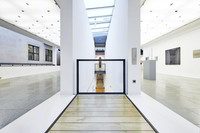A pair of moccasins from brown leather with colourful beadwork. In the front and sideways, a seam on the edge crinkles the leather. On the top side a darker piece of leather is sewed on that is edged and embroidered with the glass pearls. The inside is padded with cloth. The leather cuff that is embroidered with pearls is sewn-in a red piece of fabric.
The shoes are typically for the Iroquois in the period between 1840 and 1920 and probably come from the North American cultural area North Eastern Woodlands. Glass pearls were exchange articles of the white merchants and were used in greater numbers by the indigenous tribesmen especially in the second half of the 19th century. Probably these moccasins date back to this period. The indigenous peoples of North America wore such shoes by themselves or produced them specifically for tourists.
The shoes came into the museum's collection as a gift of the Ulm citizen Mathilde Hirsch in 1925.
en

